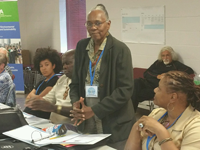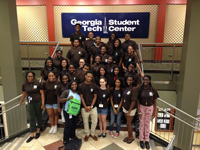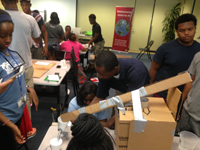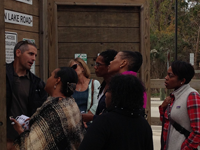Environmental Justice in Your Community
Environmental Justice Showcase Communities by Region
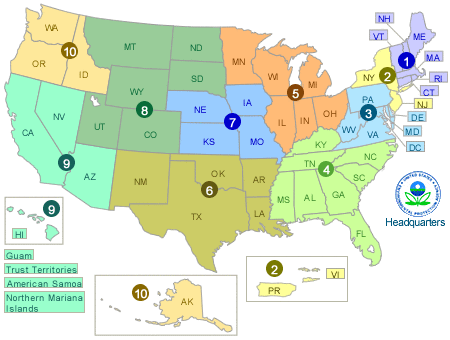
EPA Region 1: New England
Serving Connecticut, Maine, Massachusetts, New Hampshire, Rhode Island, Vermont and 10 Tribal Nations
The guiding principle of environmental justice is that everyone, regardless of race, color, national origin or income is entitled to equal protection from environmental harms and risks.
EPA Region 1 is committed to ensuring that environmental justice is integrated into all of our programs, policies and activities in order to achieve environmental and public health improvements for communities in New England that may be disproportionately burdened by environmental harms and risks, such as minority, low-income and tribal communities.
EPA Region 1 seeks to achieve environmental justice and make a visible difference in New England communities by:
- Collaborating with community members, government organizations, not-for-profit organizations, academic institutions and other stakeholders to address environmental and health-related challenges
- Enhancing understanding of environmental and health-related issues at the community level
- Providing accessible and culturally appropriate opportunities for low-income, minority and linguistically isolated stakeholders to meaningfully participate in our decision-making processes
- Providing information, tools and resources to stakeholders
- Improving methods for identifying, addressing, tracking and measuring progress toward achieving environmental justice
Please contact Jeff Norcross (norcross.jeffrey@epa.gov) to receive occasional announcements about learning opportunities, funding opportunities, conferences and other environmental justice news.
Learn more about EPA Region 1.
Region EJ Highlights
EPA-Region 1 is focused on making a visible difference and improving the environment and public health in environmentally overburdened, underserved and economically distressed communities throughout New England. Examples include:
Bridgeport, CT where EPA is building on past successes and continuing to work with a diverse range of stakeholders to:
- leverage Brownfields grants and other investments in the City to assess and revitalize underutilized sites in Bridgeport
- perform an emergency response and cleanup of the Rowayton Trading facility in Bridgeport
- promote energy and climate resiliency in the City’s houses of worship
- promote healthy homes programs to address hazards such as lead paint, mold, allergens and asthma triggers
Lawrence, MA where EPA is helping build a diverse, collaborative community stakeholder coalition working together to:
- address litter and promote increased recycling throughout the City
- protect and improve the quality of the City’s iconic rivers
- develop a comprehensive water strategy for the City
- leverage Brownfields grants and other investments in the City to revitalize the Manchester Lawrence Rail Road corridor and provide job training in site remediation and water management careers
- develop and support youth education and outreach programs
Hinsdale, NH and Brattleboro, VT, neighboring small cities, where EPA is working with a diverse range of stakeholders to:
- leverage Brownfields grants to assess and cleanup underutilized sites
- support flood mitigation efforts and create a resilience plan for Hinsdale’s drinking water treatment and distribution system
- expand capacity of citizen scientists to monitor local waterways
- promote lead-safe housing
- promote smart growth principles and climate-resilient redevelopment of Brattleboro’s Whetstone Brook Corridor
- provide storm water management training and support installation of a rain garden at the Hinsdale post office.
EPA-Region 1’s Urban Environmental Program works to improve the environment and enhance the quality of life for urban residents throughout New England by building community capacity to assess and resolve environmental problems, achieving measurable and sustainable improvements in urban communities, and restoring and revitalizing neighborhoods for urban residents.
The Healthy Communities Grant Program is EPA-Region 1’s main competitive grant program to work directly with communities to reduce environmental risks to protect and improve human health and the quality of life.
EPA’s Brownfields program has provided nearly $250 million in grants and technical assistance to New England communities, states, tribes, and other stakeholders to prevent, assess, safely clean up and sustainably reuse brownfields.
Regional EJ Resources
- Region 1 Implementation Plan to Promote Meaningful Engagement of Overburdened Communities in Permitting Activities
- Environmental Justice for CAA Permitting in EPA Region 1
Regional EJ Contacts
| Topic | Contact | Phone |
|---|---|---|
| Director, Office of Civil Rights and Urban Affairs (OCRUA) | Sharon Wells (wells.sharon@epa.gov) | 617-918-1007 |
| Director, Office of Civil Rights and Urban Affairs (OCRUA) | Jeff Norcross (norcross.jeffrey@epa.gov) | 617-918-1007 |
| Special Assistant to the Director of OCRUA and Tribal and Indigenous Peoples Advisor | Deborah Brown (brown.deborah@epa.gov) | 617-918-1706 |
EPA Region 2:
Serving New Jersey, New York, Puerto Rico, the U.S. Virgin Islands, and 8 tribal nations
EJ is a priority for EPA Region 2. The Region 2 EJ Program works to integrate the consideration of environmental justice into all of our Regional programs, functions and activities in New York, New Jersey, Puerto Rico and the U.S. Virgin Islands. Our strategy is outlined in our Regional EJ Action Plan. The Region 2 Environmental Justice Program is driven by community-based work. We provide support to various community initiatives such as EPA's Making a Visible Difference in Communities effort. We strive to interact directly with communities and work with them to address their environmental and health concerns to the best of our ability and within the scope of the Agency's authority.
Region 2 also co-leads a Regional Interagency Working Group on Environmental Justice (EJ RIWG) with the U.S. Health and Human Services based in New York. The EJ RIWG is a communities-based effort where federal partners come together to find creative solutions for some of the most economically- and environmentally-challenged areas in our region.
Region EJ Highlights
- Just one example of our community-based approach to environmental justice is a recent workshop the Region organized. With the help and partnership of the Making a Visible Difference effort, the Region 2 EJ Program successfully coordinated with state and local leaders to hold an environmental justice and education workshop in Newburgh, NY. Through the workshop, Newburgh residents and community organizations had the chance to learn, engage, discuss and build capacity to understand and address the environmental health issues that deeply impact their community.
Regional EJ Resources
- Region 2 EJ Action Plan
- Region 2 Interim EJ Policy
- Region 2 Implementation Plan to Promote Meaningful Engagement of Overburdened Communities in Permitting Activities
- Environmental Justice for CAA Permitting in Region 2
Regional EJ Contacts
| Topic | Contact |
|---|---|
|
EJ Coordinator |
Christine Ash (ash.christine@epa.gov) |
|
EJ Grants Specialist |
Tasha Frazier (frazier.tasha@epa.gov) |
|
EJ Specialist |
Carsen Mata (mata.carsen@epa.gov) |
EPA Region 3: Mid-Atlantic
Serving Delaware, District of Columbia, Maryland, Pennsylvania, Virginia and West Virginia
The EPA Mid Atlantic Region’s Environmental Justice Program is coordinated through the Office of Enforcement, Compliance and Environmental Justice (OECEJ). OECEJ coordinates the Region’s work on issues of Environmental Justice concern internally through the Region’s Environmental Justice work Group. The work group is made up of representatives from each Division/Office.
OECEJ works collaboratively to build capacity internally and externally through outreach and education in the form of training, facilitated discussions, participation in work groups and focused dialogue. We work with a variety of environmental justice stakeholders through direct work with communities and other partners on the ground. OECEJ also:
- conducts EJSCREEN assessments internally
- reviews documents of EJ concern
- conducts training
- manages grants
- serves as a conduit for information
- provides information in support of environmental justice activities throughout the Region.
Programs Activities:
- All States EJ Working Group: Since 1999, Region 3 has chaired the All States EJ Working Group, now comprised of Region’s 1-5 and their respective states. The All States EJ Working Group began by holding a face to face meeting of the EJ staff from Region 3 and the states that comprise Region 3 in June of 1999. The meeting was an information and capacity building session designed to educate and inform the attendees about Environmental Justice; as well as to encourage a further dialogue among the attendees. The session was so well received that regularly scheduled monthly conference calls were requested and have been ongoing since that time. Over time, Regions 1, 2, 4, and 5 have joined the group continuing the monthly calls and face to face sessions when possible. The calls provide a forum for discussion of issues of concern, training and capacity building opportunities, and a host of guest speaker form the states, community groups and organizations, the regions and OEJ to name a few.
- EJSCREEN – OECEJ conducts EJCREEN sessions for all sites in Region 3.
- National Environmental Policy Act (NEPA) EJ Reviews – OECEJ conducts EJ reviews for Regional EIS documents.
- EJ Mapping – OECEJ works with the divisions to provide digital maps and other information related to environmental justice issues and areas of concern.
Regional EJ Highlights
- The Chester, PA Environmental Risk Study was our first attempt to characterize and address risk from an EJ standpoint. This document is presented to provide historical perspective.
Regional EJ Resources
- Region 3 Implementation Plan to Promote Meaningful Engagement of Overburdened Communities in Permitting Activities
- CAA Permitting in EPA Region 3
Regional EJ Contacts
| Topic | Contact | Phone |
|---|---|---|
| OECEJ | Samantha Beers (beers.samantha@epa.gov) | 215-814-2627 |
| EJ Coordinator, Toxicologist | Reggie Harris (harris.reggie@epa.gov) | 215-814-2917 |
| GIS/EJSCREEN/EJ | Matthew Lee (lee.matthew@epa.gov) | 215-814-2917 |
| EJ | Erin Sullivan (sullivan.erinc@epa.gov) | 215-814-5564 |
EPA Region 4: Southeast
Serving Alabama, Florida, Georgia, Kentucky, Mississippi, North Carolina, South Carolina, Tennessee and 6 Tribes
The Office of Environmental Justice and Sustainability (OEJS) is located directly in the Office of the Regional Administrator (ORA) and plays a critical role in leading and coordinating the region’s environmental justice and sustainability programs. These functions are placed in the ORA to illustrate the elevated level of significance in the Region.
The mission of OEJS is to promote sustainable communities that foster improvements in human health, the environment and economic well-being for all; with a focus on minority, low-income, tribal and vulnerable communities. OEJS serves Alabama, Florida, Georgia, Kentucky, Mississippi, North Carolina, South Carolina, Tennessee, and Six Tribes.
OEJS plays a critical role in the implementation of Plan EJ2014, the EJ 2020 Action Agenda and the Regional Interagency Working Group for Environmental Justice, as well as consultation activities throughout the region on technical issues in environmental justice communities.
Focus Areas
- Partnerships
OEJS integrates sustainability and environmental justice through various external partnerships. These partnerships are essential to ensuring our communities, elected officials, industry partners, academics and other stakeholders stay abreast of the opportunities available to them at EPA and beyond. While OEJS staff is represented on a number of different partnerships, OEJS has identified eight major partnership areas.
- Outreach
OEJS is committed to outreach to communities, industry, academics, elected officials and other stakeholders to help them work toward reducing environmental pollution, enhancing economic development and creating sustainable communities.
- Training
Financial Assistance Agreements
Training is the means by which stakeholders make more informed decisions about their future direction. OEJS will continue to develop and deliver training to partners and to internal R4 staff to educate them about environmental justice, sustainability and pollution prevention issues.
Multi-media Collaboration (internal)OEJS staff is responsible for a varied list of financial agreements. These grants, contracts and cooperative agreements are awarded on an annual basis to eligible community groups, states, and federally recognized governments that are working on or planning to carry out projects to address environmental justice.
Many of the issues that communities and other stakeholders face are not one dimensional; these issues cross many different EPA Programs, requiring coordination and assistance from different media (i.e., air, water, waste) offices. One method of cross program coordination is working through workgroups and councils.
Region EJ Highlights
- Region 4 OEJS Making a Visible Difference in Communities
Proctor Creek:
EPA continues to strengthen collaborations with communities, governmental partners and other interested stakeholders to achieve meaningful outcomes in the Proctor Creek Watershed. EPA has successfully used a Health Impact Assessment (HIA) to assess the distribution of both environmental and health impacts of a proposed area-wide environmental district. The HIA helped determine how green infrastructure techniques and practices, low impact development and land-use planning can help solve the complex flooding and stormwater issues in Proctor Creek. Read more about the Proctor Creek HIA.North Birmingham:
EPA has taken a coordinated approach to evaluate and address the environmental conditions and potential environmental hazards in low-income and minority communities of North Birmingham, including the neighborhoods of Fairmont, Collegeville and Harriman Park, as well as portions of Five-Mile Creek and the Harriman Park Ditch. This effort, which includes air, waste and water issues, is known as the North Birmingham Environmental Collaboration Project.EPA Regional Administrator Heather McTeer Toney convened the Interagency Working Group on Environmental Justice (EJ IWG), to bring federal support to address the myriad of needs in North Birmingham. Since the formation of the IWG which includes local agencies and colleges, small working groups meet regularly to further define priority projects, performance measures, community goals, and identify key stakeholders to leverage or share resources.
In July 2015, Region 4 hosted a series of Summer Camps in the North Birmingham, AL area. Through a partnership with the City of Birmingham, EPA staff educated the youth about the clean-up activities in the area and provided them with knowledge about healthy living.
"These summer camps are an excellent way, for us as the EPA, to educate the youth on what we do as an organization and show them that what we can do together as a civilization, and how our daily activities directly impact the earth and our health," stated Cynthia Peurifoy, Environmental Justice Coordinator for the EPA Region 4. More than 120 children participated in the four camps.
- Region 4 EJ Showcase Community
Jacksonville, Florida is Region 4’s Environmental Justice Showcase Community. EPA Region 4 OEJS worked with the City of Jacksonville and numerous local stakeholders to improve environmental and public health outcomes in an area that consists of a predominantly low income and minority population. This Jacksonville area has a number of Superfund sites, Brownfields, vacant and abandoned lots or other properties where contamination is suspected and impacted waterways. Region 4 has worked with its partners, including environmental justice community representatives, to address sites of concern and turn them into an opportunity for residents in the vicinity to collaborate with developers and revitalize their neighborhoods. Read more about Jacksonville, Florida Health Zone 1.
- Region 4 EJ Programming
EJ Academy
OEJS developed the Environmental Justice Academy (EJA) to educate leaders from communities facing environmental injustices. Primarily based on EPA’s Collaborative Problem-Solving Model, EJA also incorporates the concepts associated with Appreciative Inquiry (AI). AI is a change management approach to identify what is working well, analyze why it is working and take action to do more of it. Through a series of nine modules, EJA participants cultivate skills to identify environmental challenges and accomplish environmental improvement goals in their communities. Participation is open to residents as well as representatives of grassroots community organizations and academia. EJA encourages collaborative problem-solving with local government, small businesses, academic institutions and industry to create a shared vision among different stakeholders so that all parts of a community have a voice.Community Engagement University
In 2016, OEJS will implement the Community Engagement University (CEU) Certificate Program to educate internal stakeholders about the complexities, challenges and rewards of working in communities. The CEU Program is designed to help staff do their work more effectively, fostering community engagement skills through a series of classroom and web-based courses that will be taught by EPA staff and consultants.Earth Tomorrow
OEJS has supported the Earth for Tomorrow Summer Institute, hosted by the National Wildlife Federation, since its inception in 2001. The program engages high school students in hands-on leadership training and interaction with environmental professionals though a career fair, fieldwork and other outdoor experiences.The program focuses on creating a new generation of leaders that will promote environmental stewardship and raise awareness about the human health impacts of environmental pollution. OEJS staff has hosted an annual “EJ Day” during the Summer Institute. Last year’s EJ Day focused on the Climate Justice Movement, expanding students’ understanding of climate change impacts on vulnerable populations.
Regional EJ Resources
- Region 4 Implementation Plan to Promote Meaningful Engagement of Overburdened Communities in Permitting Activities
- Environmental Justice for CAA Permitting in EPA Region 4
Regional EJ Contacts
| Topic | State | Contact | Phone |
|---|---|---|---|
| Director | Denise Tennessee, P.E. (tenneessee.denise@epa.gov), Environmental Justice and Sustainability Program Director |
404-562-9649 | |
| EJ 2020 Action Agenda, Regional EJ Interagency Working Group | NC | Cynthia Peurifoy (peurifoy.cynthia@epa.gov), Region 4 Environmental Justice Coordinator |
404-562-9649 |
| Rural Communities, Partnership for Sustainable Communities, Smart Growth | FL | Denise Tennessee, P.E. (tenneessee.denise@epa.gov), Environmental Justice and Sustainability Program Director |
404-562-9649 |
| Public Health, Tribal Coordination | AL & GA | Tami Thomas-Burton (thomas-burton.tami@epa.gov), Environmental Scientist |
404-562-8027 |
| EJ Academy, Community Engagement University | KY | Sheryl Good (good.sheryl@epa.gov), Environmental Scientist |
404-562-9559 |
| EJSCREEN, Strategic Planning | SC | Latoya Miller (miller.latoya@epa.gov), Life Scientist |
404-562-9885 |
| Children’s Health, EJ Hotline Database, Interagency Collaboration | TN | Siobhan Tarver (tarver.siobhan@epa.gov), Physical Scientist |
404-562-8299 |
| Climate Change, Citizen Science | MS | Christian Braneon (braneon.christian@epa.gov), Physical Scientist |
404-562-9608 |
| N/A | N/A | Deborah Carter (carter.deborah@epa.gov), Environmental Justice Grants Coordinator |
404-562-9649 |
| N/A | N/A | Karen Smith (smith.karen@epa.gov), Office Assistant |
404-562-9703 |
Photo Gallery
EPA Region 5: Great Lakes
Serving Illinois, Indiana, Michigan, Minnesota, Ohio, Wisconsin and 35 tribes
The Region 5 Environmental Justice program works regularly with community organizations in a variety of ways including by hosting and attending community meetings. Region 5 has a strong relationship with co-regulators at the state and local level. We collaborate with states on geographic initiatives and provide the states with technical support including training.
Region 5 works to achieve environmental justice in its enforcement, permitting, and community-based work, as part of a comprehensive national commitment to consider environmental justice in all aspects of EPA’s decision-making process:
- Enforcement programs assure compliance with federal laws that protect public health and the environment, holding all facilities to an equal standard wherever they are located and focusing our attention on areas where there are potential disproportionate impacts.
- Permitting programs ensure that permits are issued in accordance with federal law and that surrounding communities are equally protected. In some cases Region 5 issues permits to facilities, in others they oversee state run permitting programs. They also offer training to states and promote best practices for effective public participation.
- Community-based work brings a full range of program resources to communities living with Environmental Justice concerns. Working with community residents and organizations, we partner with other federal, state, and local agencies to address these concerns and make a visible difference.
Region EJ Highlights
- Environmental Justice in Region 5, 2015 Highlights
- Examples of how EPA programs impacted communities with environmental justice concerns during 2015.
- EJ program helps Detroit community get the greenspace they want
- One story of EPA supporting community led environmental improvements.
Regional EJ Resources
- Region 5 EJ Program Factsheet
- Region 5 Implementation Plan to Promote Meaningful Engagement of Overburdened Communities in Permitting Activities
- Environmental Justice in CAA Permitting in EPA Region 5
Regional EJ Contacts
| Topic | Contact | Phone |
|---|---|---|
| EJ Coordinator | Lara Lasky (lasky.lara@epa.gov) | (312) 353-5614 |
| EJ Mapping | Mark Messersmith (messersmith.mark@epa.gov) | (312) 353-2154 |
State EJ Contacts
- Region 5 actively works with our state and local co-regulators on environmental justice concerns. We work together to encourage adoption of best practices. The contacts below would like to share more information about their state EJ programs with you.
Agency |
Contact |
Website (exit disclaimer) |
|
Illinois Environmental Protection Agency
|
Ken Page
(217) 524-1284
|
|
|
Indiana Department of Environmental Management
|
Valerie Tachtiris
(317) 234-8884
|
No website
|
|
Michigan Department of Environmental Quality
|
Chad Rogers
(517) 284-6872
|
|
|
Minnesota Pollution Control Agency
|
Ned Brooks
(651) 757-2557
|
|
|
Ohio Environmental Protection Agency
|
Mary McCarron
(614) 644-2160
|
|
|
Wisconsin Department of Natural Resources
|
Andrew Savagian
(608) 261-6422
|
No website
|
EPA Region 6: South Central
Serving Arkansas, Louisiana, New Mexico, Oklahoma, Texas and 66 Tribal Nations
The Office of Environmental Justice, Tribal, and International Affairs works closely with communities to facilitate culturally sensitive communication, find solutions, or reduce environmental challenges. The Environmental Justice program’s goal is to ensure that all people are protected from disproportionate impacts of environmental hazards by working with and on behalf of impacted communities.
Environmental Justice is about real people facing real problems and designing practical solutions to address challenging environmental issues. The environmental justice movement advocates programs that promote environmental protection within the context of sustainable development. The Environmental Justice program administers EJ Small Grants and EJ Collaborative Problem-Solving (CPS) Cooperative Agreement Program.
Environmental Justice State Collaborative Action Plans
- Arkansas Action Plan
- Louisiana Action Plan
- New Mexico Action Plan
- Oklahoma Action Plan (In progress-Coming soon!)
- Texas Action Plan
Region 6 Environmental Justice Summit, August 9-10, 2016, Dallas, Texas
Regional EJ Resources
- Region 6 Environmental Justice Strategy is a broad set of principles designed to address the goals of the FY14-FY18 Cross Agency Strategy for Working to Make a Visible Difference in Communities.
- Region 6 Implementation Plan to Promote Meaningful Engagement of Overburdened Communities in Permitting Activities
- Environmental Justice for CAA Permitting in EPA Region 6
Regional EJ Contacts
| Topic | Contact | Phone |
|---|---|---|
| Director | Arturo Blanco | 214-665-3182 |
| Deputy Director | Rhonda Smith | 214-665-8006 |
| Associate Director of Environmental Justice | Gloria Vaughn | 214-665-7535 |
| EJ Liaison - Oklahoma | Omari Burrell | 214-665-2719 |
| EJ NEPA/EJScreen Coordinator | Agatha Benjamin | 214-665-7292 |
| EJ Liaison - Texas | Paula Flores-Gregg | 214-665-8123 |
| EJ Liaison - Louisiana | Charlotte Runnels | 214-665-6442 |
| EJ Liaison - Arkansas | Tressa Tillman | 214-665-2261 |
| EJ Liaison - New Mexico & U.S./Mexico Border | Debra Tellez | 915-533-7273 Ext. 229 |
EPA Region 7: Midwest
Serving Iowa, Kansas, Missouri, Nebraska and Nine Tribal Nations
The primary focus of the Region 7 Environmental Justice Program is to ensure that, as a Region, we are fulfilling the mandate given in Executive Order 12898 on environmental justice.
Fulfilling this mandate means ongoing efforts to both ensure that Region 7 is addressing environmental justice in all we do and ensure community awareness regarding environmental issues and the decision-making processes in areas which affect their daily lives. The program maintains its outreach and education activities where grants programs and Agency participation in community activities have produced tangible environmental benefits for low-income and minority communities.
Our Vision
- Meaningful involvement of low-income and minority populations in our decision-making processes.
- Greater understanding of environmental and health-related issues at the community level.
- The ability to identify, address, track and measure Region 7's progress towards ensuring environmental justice at sites located in low-income and minority communities.
- Collaboration with federal, state and local governments, not-for-profit organizations, academic institutions, and other stakeholders to ensure environmental justice.
Regional EJ Highlights
- Region 7 Health Homes Community Initiative
Regional EJ Resources
- Region 7 Implementation Plan to Promote Meaningful Engagement of Overburdened Communities in Permitting Activities
- Environmental Justice for CAA Permitting in EPA Region 7
Regional EJ Contacts
| Topic | Contact |
|---|---|
| EJ Coordinator | Althea Moses (moses.althea@epa.gov) |
EPA Region 8: Mountains and Plains
Serving Colorado, Montana, North Dakota, South Dakota, Utah, Wyoming and 27 Tribal Nations
Region 8’s environmental justice program is focused on achieving equal environmental protection so no segment of the population, regardless of race, ethnicity, culture, or income bears an undue burden of environmental pollution and to ensure that the benefits of environmental protection are shared by everyone. Region 8’s EJ Team works towards advancing environmental justice by focusing on making a difference in environmental justice communities through connecting with, supporting, building the capacity of, and leveraging resources of both internal and external partners.
Region 8 is predominantly rural in character and home to some traditionally disenfranchised and historically self-reliant populations including Native Americans, migrant farm workers, Latinos, and the rural poor. These populations tend to inhabit places that are physically distant and isolated from urban centers. Indian country in the Region encompasses a large land area.
The Region 8 EJ Team’s principal focus areas are to effectively integrate environmental justice into the activities of EPA Region 8, build effective partnerships with external stakeholders, and respond to challenges posed to communities impacted by oil and gas development.
Region EJ Highlights
The following are examples of key efforts in Region 8 that are benefitting the Region’s EJ communities:
- The Recycle Conejos and Costillos Counties project made possible by an EPA Collaborative Problem Solving (CPS) grant is focused on addressing illegal dumping of waste in the San Luis Valley in southern Colorado. EPA and other stakeholders are working with the grantee to enhance cooperation and efficiency regarding waste collection and disposal and integrate, through the development of transfer stations, the illegal dumping waste stream into recycling operations. To date, most of the site identification has been completed and analysis is underway and the team has successfully coordinated with local schools with students participating in site visits to discuss illegal dumping and an illegal dump site mapping project.
- Through the Poplar, Montana / Fort Peck Reservation Making a Visible Difference (MVD) project, Region 8 is engaging the Assiniboine and Sioux Tribes at Fort Peck, and the town of Poplar, MT, specifically focused on a theme of sustainable living. During summer and fall of 2015, 20 high efficiency, LEED Platinum homes are being built by the Make-It-Right Foundation and installed in the first phase of development of a new “Sustainable Village” in Poplar. EPA is providing Brownfields technical and grant assistance to address a former landfill and airport located within the Village footprint. EPA is also working with the Tribe and other partners to create healthy home, school, and work environments; assess and remove blighted properties and work towards a long-term plan to manage abandoned or damaged properties in the future; apply green infrastructure principles to manage storm water; and provide climate change mitigation, training, and adaption planning.
- EPA Region 8 is supporting efforts to assess and cleanup environmental contamination and revitalize an economically distressed and historically industrial area of Helena, Montana through the Queen City Crossing & 6th Ward Neighborhood MVD project. Efforts include the implementation of livability/smart growth principles that will benefit residents in the 6th Ward neighborhood. The focus area contains the greatest number of brownfield sites and vacant or transitioning commercial properties in Helena. Partners are collaborating to redesign traffic flow, increase connectivity with bicycle and pedestrian access, facilitate mixed-use and equitable development and become a community-friendly gateway to the downtown area.
- The Denver, Colorado / Sun Valley Neighborhood MVD project focuses on implementation of the Decatur-Federal Station Area Plan (developed through a HUD Sustainable Communities Grant). As a major implementation step, the Denver Housing Authority is creating a master plan for a high density, mixed income, rental and ownership community that includes mixed-use commercial space and which explores EcoDistrict solutions for multiple sustainability issues such as energy, water management, transportation and food production. EPA Region 8 is working with various partners on redevelopment of the 33 acre public housing site including a net zero district, creating a South Platte Greenway/Riverfront Park, comprehensive storm water design, healthy homes education and industrial area cleanup.
Regional EJ Resources
- Region 8 Implementation Plan to Promote Meaningful Engagement of Overburdened Communities in Permitting Activities
- Environmental Justice for CAA Permitting in EPA Region 8
Regional EJ Contacts
| Topic | Contact |
|---|---|
|
EJ Coordinator |
Corbin Darling (darling.corbin@epa.gov) |
|
EJ Tribal and Indigenous Peoples Advisor |
Suzanne Bohan (bohan.suzanne@epa.gov) |
|
EJ Specialist (grants, EJSCREEN) |
April Nowak (nowak.april@epa.gov) |
|
EJ Specialist (enforcement, tribal) |
Jean Belille (belille.jean@epa.gov) |
|
EJ Specialist (community engagement) |
Michael Wenstrom (wenstrom.michael@epa.gov) |
EPA Region 9: Pacific Southwest
Serving Arizona, California, Hawaii, Nevada, Pacific Islands and 148 Tribes
EPA Region 9 supports programs and projects to help address adverse and disproportionate effects. Here you will find examples of the ways communities have used EPA funding to increase their capacity to improve their local environment. We have also provided a list of tools and resources that may be useful to environmental justice organizations and residents.
Regional EJ Highlights
-
Subscribe to the Region 9 EJ Update Newsletter: EPA's Pacific Southwest Environmental Justice Network sends occasional updates about funding opportunities, conferences, events, and other information that may be of interest to environmental justice organizations and practitioners. Read previous Updates.
-
Join Region 9’s EJ Mailing List to receive occasional announcements about funding opportunities, conferences, or environmental justice news. You can always opt out of your subscription by using the SafeUnsubscribe® link found at the bottom of every email.
- In recognition of the 20th anniversary of the EJ Executive Order, EPA Region 9 organized a "Teach-In" on March 6, 2014. More than 150 participants representing nonprofits, community organizations, academia, state and local governments, and the Region 9 workforce provided input on three key themes. Learn more:
- Sustainable Development and EJ
- EJ and the Law
- Tools and Task Forces
Regional EJ Resources
- The FY2015 EJ Action Plan continues the process begun in 2014, with each Region 9 Division responsible for integrating EJ into its work. The new region-wide EJ Network develops and follows through on shared EJ commitments in places and projects, based on our permitting and enforcement initiatives and the use of EJSCREEN, EPA's nationally consistent screening tool for environmental justice.
- Region 9 Implementation Plan to Promote Meaningful Engagement of Overburdened Communities in Permitting Activities
- Environmental Justice for CAA Permitting in EPA Region 9
Regional EJ Contacts
Do you have a program-specific question about Environmental Justice? Check out the list of network members below and the EJ-related topics of interest they are knowledgeable about. If you don’t find what you’re looking for, please contact the EJ Coordinator.
| Topc | Contact | Phone |
|---|---|---|
|
Lead EJ Coordinator, Trainer, Liaison to State and Local Agencies for EJ |
Deldi Reyes (reyes.deldi@epa.gov) | 415-972-3795 |
| Air Division | ||
| Indoor Air, Air Toxics and EJ | Mike Bandrowski (bandrowski.mike@epa.gov) | 415-947-4194 |
| Lead, Region 9 EJ and permitting workgroup | Richard Grow (grow.richard@epa.gov) | (415) 947-4104 |
| Enforcement Division | ||
| EJ Grants Coordinator | Andrea Manion (manion.andrea@epa.gov) | 415-947-4184 |
| R9 Contact for EJSCREEN | Charles Swanson (swanson.charles@epa.gov) | 415-947-4219 |
| Land Division | ||
| Public health and children’s health and EJ | Jacquelyn Menghrajani (menghrajani.jacquelyn@epa.gov) | 415-972-3259 |
| RCRA and TSCA EJ-related issues | Omer Shalev (shalev.omer@epa.gov) | 415-972-3538 |
| Superfund Division | ||
| Brownfields and EJ | Nova Blazej (blazej.nova@epa.gov) | 415-972-3846 |
| Risk Assessment, Toxicology and EJ | Dr. Sophia Serda (serda.sophia@epa.gov) | 415-972-3057 |
| Water Division | ||
| Water Division grants and EJ | Loretta Vanegas (vanegas.loretta@epa.gov) | 415-972-3433 |
| NPDES Permitting and EJ | Pascal Mues (mues.pascal@epa.gov) | 415-972-3768 |
| Office of Public Affairs | ||
| Public Affairs Specialist, Los Angeles | Nahal Mogharabi (mogharabi.nahal@epa.gov) | 213-244-1815 |
| Office of the Regional Counsel | ||
| Title VI of the Civil Rights Act and EJ | Desean Garnett (garnett.desean@epa.gov) | 415-972-3046 |
EPA Region 10: Pacific Northwest
Serving Alaska, Idaho, Oregon, Washington and 271 Native Tribes
The Region 10 EJ program works to integrate the principles of environmental justice throughout the four states of Idaho, Alaska, Oregon and Washington. This goal is accomplished through grantmaking, direct collaboration with communities and tribes, close coordination with states and other governmental agencies and participation with universities, research centers and other entities involved in extending the discourse on environmental justice.
The program also prioritizes the integration of environmental justice within the Regional office through strategic planning, training and working across programs on the Agency’s core work of permitting, enforcement, Superfund and other functions. The Region 10 Environmental Justice program is currently located in the Community Engagement and Environmental Health unit of Office of Ecosystems, Tribal and Public Affairs. The Regional Community Involvement Coordinators and the Children’s Environmental Health contact mutually support accomplishing the goals of environmental justice and quality community engagement.
Regional EJ Highlights
- Environmental Justice Partners Conference Call: EPA Region 10 convenes regional stakeholder conference calls to help continue the conversation on environmentalism and environmental justice. Please submit suggestions for topics and agenda items to Sheryl Stohs. For more information contact Sheryl Stohs at 206-553-0250.
Regional EJ Resources
- Region 10 EJ Strategic Roadmap for 2013-2014 (PDF) (37 pp, 590 K, About PDF)
- Region 10 Implementation Plan to Promote Meaningful Engagement of Overburdened Communities in Permitting Activities
- CAA Permitting in EPA's Pacific Northwest Region
Regional EJ Contacts
| Topic | Contact | Phone |
|---|---|---|
| EJ Coordinator | Running Grass (grass.running@epa.gov) | 206.553.2899 |
| EJ Small Grants Coordinator | Sheryl Stohs (stohs.sheryl@epa.gov) | 206.553.0250 |



